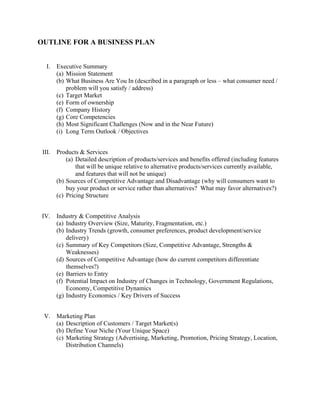Outline for a business plan (revised)
- 1. OUTLINE FOR A BUSINESS PLAN I. Executive Summary (a) Mission Statement (b) What Business Are You In (described in a paragraph or less – what consumer need / problem will you satisfy / address) (c) Target Market (e) Form of ownership (f) Company History (g) Core Competencies (h) Most Significant Challenges (Now and in the Near Future) (i) Long Term Outlook / Objectives III. Products & Services (a) Detailed description of products/services and benefits offered (including features that will be unique relative to alternative products/services currently available, and features that will not be unique) (b) Sources of Competitive Advantage and Disadvantage (why will consumers want to buy your product or service rather than alternatives? What may favor alternatives?) (c) Pricing Structure IV. Industry & Competitive Analysis (a) Industry Overview (Size, Maturity, Fragmentation, etc.) (b) Industry Trends (growth, consumer preferences, product development/service delivery) (c) Summary of Key Competitors (Size, Competitive Advantage, Strengths & Weaknesses) (d) Sources of Competitive Advantage (how do current competitors differentiate themselves?) (e) Barriers to Entry (f) Potential Impact on Industry of Changes in Technology, Government Regulations, Economy, Competitive Dynamics (g) Industry Economics / Key Drivers of Success V. Marketing Plan (a) Description of Customers / Target Market(s) (b) Define Your Niche (Your Unique Space) (c) Marketing Strategy (Advertising, Marketing, Promotion, Pricing Strategy, Location, Distribution Channels)
- 2. OUTLINE FOR A BUSINESS PLAN (CONTINUED) VI. Operations Plan (a) How and Where You Produce/Deliver Your Products/Services (b) Legal Environment: (i) Licensing & Bonding Requirements, (ii) Other Permits, (iii) Health, Workplace or Environmental Regulations, (iv) Other Special Regulations Covering Your Industry, (v) Zoning or Building Code Requirements, (vi) Insurance Coverage, (vii) Intellectual Property (c) Personnel (Description of Staff Required) (d) Inventory (e) Suppliers (f) Credit Policies VII. Value Creation / Growth Strategy (a) Summary of Each Planned Growth or Operational Improvement Initiative, and Expected Impact On Financial Performance VIII. Management & Organization (a) Organizational Chart (b) Roles & Responsibilities of Key Positions (c) Bios for key senior management (c) Board of Directors / Advisory Board (d))Professional Support (Banker, Accountant, Attorney, Insurance Agent, Consultants) IX. Historic Financial Performance (a) Summary Income Statements, Balance Sheets, Cash Flow Statements (b) Key Economic Drivers and Financial Ratios (c) Management’s Discussion of Financial & Operating Performance X. Projected Financial Performance (a) Summary Income Statements, Balance Sheets, Cash Flow Statements (b) Key Economic Drivers and Financial Ratios XI. Primary Risks & Mitigating Factors XII. Appendices / Supporting Materials

